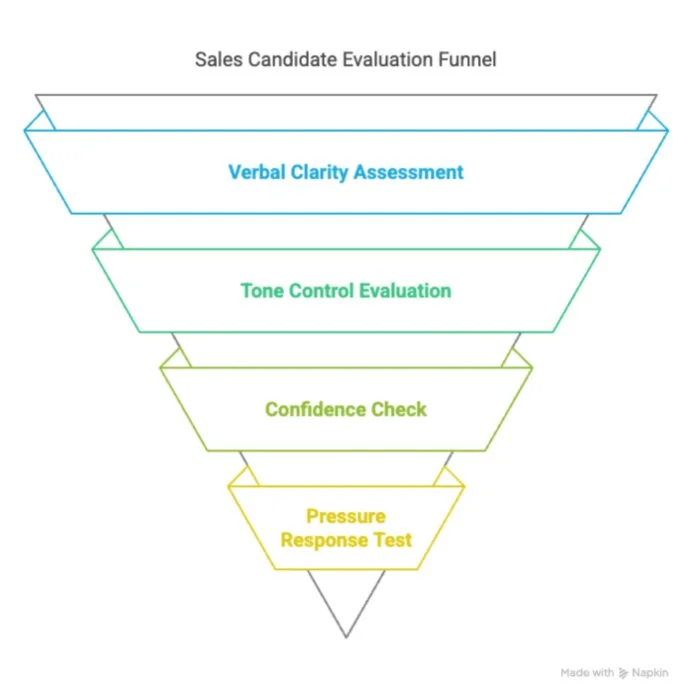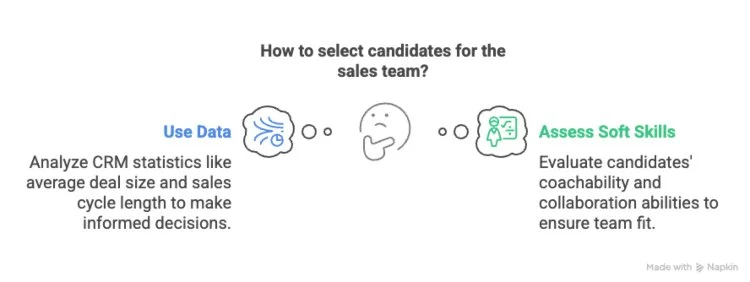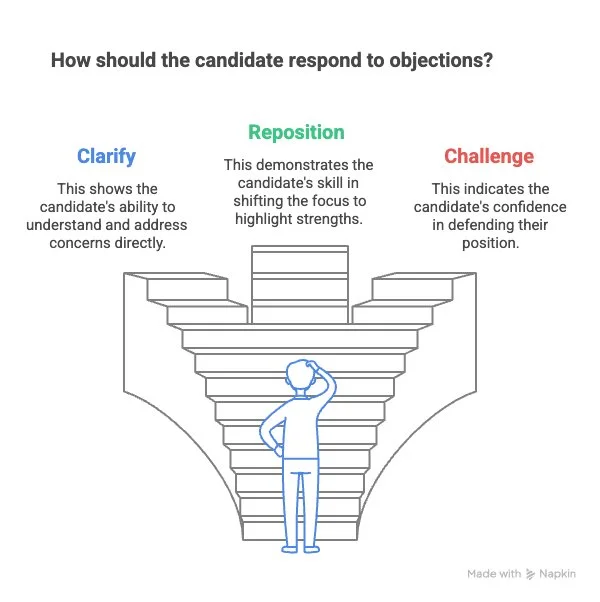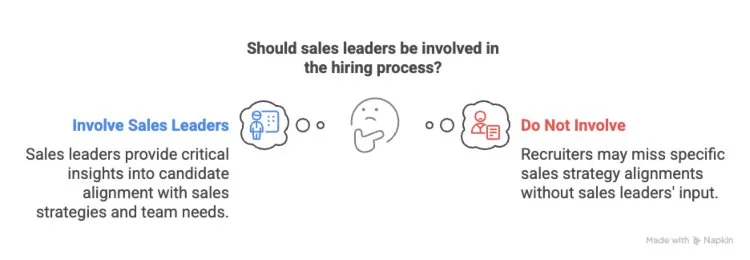How to Narrow Down Amazing Sales Hires with Your Interview Process
Hiring for a sales position isn’t about getting more job candidates. It’s about picking the right ones.
The sales recruitment process needs structure. Without it, you waste time on people who can’t hit sales goals or fit the sales team.
Your interview process should filter for real sales talent. You want sales professionals who can handle rejection, ask smart questions, and close deals.
That means screening for soft skills and sales experience. It means checking if they’ve met a sales quota, worked a long sales cycle, or crushed a B2B sales role.
This guide shows you how to do that.
You’ll learn how to write a job description that attracts the ideal candidate. How to use phone interviews and skills assessment to sort potential employees. And how to ask sales interview questions that reveal sales success.
Let’s cut the guesswork. Here’s how to build an effective sales interview process.
Why Is the Right Interview Process So Important in Sales Hiring?
Sales hiring mistakes are expensive. A bad sales hire misses targets, hurts team morale, and slows business growth.
That’s why the right interview process matters.
1. Sales is Performance-Driven
Unlike other roles, sales success is easy to measure. Did they hit their sales quota? Did they bring in revenue? Your sales interview process should filter out candidates who can’t prove past performance in a sales position.
2. Sales Requires a Unique Skill Set
Great sales people need more than charm. You’re looking for soft skills like listening, resilience, and emotional intelligence. You also need to test sales skills like objection handling and closing.
3. It Helps Spot Red Flags Early
Structured phone screenings and person interviews help you see issues before they become hiring regrets. It’s your chance to check for inflated sales experience or poor communication.
4. It Reduces Employee Turnover
A strong interview process means you’re more likely to hire a qualified candidate who fits your sales team and sales strategy. That leads to better employee retention and fewer missed sales targets.
5. It Protects the Whole Sales Process
One underperforming sales rep can drag down the entire sales cycle. A smart process protects your pipeline—and your revenue.
10 Tips to Plan and Conduct Interviews That Attract Top Sales Talent
1. Treat the Job Description Like a Sales Pitch
A job description isn’t just a checklist—it’s your first shot at attracting top sales talent. Think of it as a kind of outbound sales. If your messaging doesn’t hook the right potential candidates, your pipeline suffers.
Instead of listing vague responsibilities like “generate leads” or “maintain client relationships,” focus on outcomes. Mention specific sales goals. Explain what kind of sales cycle they’ll be managing. Outline the company’s sales strategy and what tools they’ll be using. This tells job seekers exactly what they’re stepping into — and whether they’re built for it.
Highlight what success looks like. State what an ideal candidate should accomplish in their first 90 days. For example, “Close $50K in new business within three months” is clear, measurable, and motivating. 72% of hiring managers say they provide clear performance goals, yet only 36% say they’re given clear job descriptions.
Use this space to prequalify serious sales professionals. If you want experienced salespeople with B2B sales skills or who have hit a $1M sales quota, say that. The more your job posting sounds like a high-conviction pitch, the more likely you are to attract an ideal salesperson who fits your sales role and company.
Here are some key things your sales job description should include:
2. Source from Niche Job Boards and Passive Candidates
If you only post on generic job boards, you’re fishing in the same pool of candidates as every other company. That’s a problem, especially for sales roles where competition for top talent is high. Instead, use a niche job board that specializes in sales professionals. Platforms like SalesHeads, Rainmakers, or even specific B2B sales communities help you reach candidates who already understand sales goals, the sales process, and what it takes to succeed in a quota-driven environment.
You should also go after passive candidates. These are people who aren’t active job seekers but might consider switching if the right opportunity comes along. LinkedIn is your best tool here. Use filters to target by sales title, industry, and years of sales experience. A LinkedIn study found that 70% of the global workforce is made up of passive candidates—only 30% are actively looking for work, as shown by the image below. That’s a huge opportunity to reach experienced salespeople who won’t see your job postings but might be perfect for your sales team.
Sourcing this way also helps with quality. Passive candidates tend to be employed and performing. If they’re willing to talk, it’s because your job description resonated with them. That alone filters for a higher level of sales talent.
3. Start With a Phone Screening Script
Phone screenings are your first filter in the sales recruitment process. You’re not just verifying resume details—you’re listening for traits that matter in a sales role: verbal clarity, tone control, confidence, and the ability to think fast under pressure. A good sales candidate should be able to talk through their sales experience without rambling, dodge fluff, and respond like they’re already in a client call. The funnel below shows how you might evaluate a sales candidate on an initial call.
You can even bake light objection handling into your script. Say something like, “This role has a steep sales target in the first quarter—does that concern you?” How they respond gives you a preview of their mindset under sales pressure.
According to SHRM, phone interviews typically last 20-30 minutes. But in sales hiring, your phone screenings aren’t just about consistency — they’re about spotting sales talent fast.
A smart script helps you stay objective. Ask each candidate the same sales interview questions and note how well they pitch themselves. You’re not looking for the “best talker” — you’re looking for someone who sounds like they could sell your product tomorrow.
4. Benchmark Against Current Employees Who Perform
One of the most reliable ways to improve your sales hiring is to reverse engineer what already works. Look at your current employees — especially the top-performing sales reps — and break down why they’re successful. What sales skills do they use daily? Do they follow a certain sales process? What kind of customer service approach sets them apart? This forms the “ideal profile” you can use to evaluate new job candidates.
Don’t just rely on a gut feeling. Use data. Review CRM stats like average deal size, sales cycle length, or lead-to-close ratio. As shown below, combine that with soft skills: Are they coachable? Do they collaborate well with the sales team? Then, look for similar traits in your pool of candidates.
Research suggests that companies that use structured, skills-based hiring practices see up to an 89% reduction in the cost-to-hire, a 91% reduction in the time-to-hire, and a 91% increase in employee retention.
In sales, that translates directly to higher revenue stability and lower employee turnover.
You’re not cloning people—you’re setting a standard. When potential candidates meet or exceed benchmarks tied to actual sales success in your company, you’re not guessing. You’re making strategic hiring decisions based on what’s already working.
5. Ask Tactical Sales Interview Questions
Generic interview questions won’t tell you how someone performs in a high-stakes sales environment. Sales professionals are trained to talk themselves up, so you need to go deeper. Ask questions that force them to explain their thinking, process, and outcomes. For example: “Walk me through the steps you took to close your last six-figure B2B sales deal.” This type of question can shed more light on how they manage the sales cycle, handle objections, and adapt their strategy to hit a sales quota.
Focus on specificity. Ask about sales targets they’ve met, what tools they used (CRM, email cadences, lead gen platforms), or how they prioritized accounts. This helps you understand if they’re just repeating buzzwords or if they have actual sales experience. A LinkedIn report found that 80% of companies say soft skills are increasingly important for company success. Tactical questions, like those shown below, uncover both.
You can also role-play sales interview questions to simulate real interactions. For example, have them sell your product back to you. Their performance will give you a live sample of how they might represent your brand — and whether they’re just a resume or a real sales executive in action.
6. Inject a Mini Objection Handling Test
In sales, rejection is part of the job. That’s why a strong sales interview process should include an objection handling test — even during the interview. At some point in the conversation, say something like, “I’m not sure you have the right background for this sales role,” or “We’ve had stronger candidates with more direct sales experience.” Then pause. How the sales candidate responds tells you everything about their mindset and confidence.
A great salesperson won’t freeze or retreat. They’ll clarify, reposition, or challenge the objection with professionalism (as you can see below). This isn’t about being aggressive—it’s about testing how they handle pressure and protect value. According to HubSpot, sales staff who can successfully defend their product against buyers’ objections have a close rate as high as 64%. But if they can’t manage one in a job interview, they’ll likely struggle with customers, too.
This simple extra step gives you insight into how a candidate behaves under tension. It separates those who rehearse answers from those who can think on their feet—an essential skill for any sales representative working toward tough sales targets.
7. Involve the Sales Leader in the Interview Loop
The sales leader is closest to the front lines. They know what’s working, where the gaps are, and what kind of sales skills their team actually needs. That makes their input critical during in-person interviews — and this is especially true for final-round candidates.
They’ll spot things a recruiter might miss, like whether someone’s sales strategy aligns with the current sales process or if their sales experience is relevant to the company’s sales cycle. The graphic below shows what’s at stake.
Bringing the sales leader into the interview loop also signals to candidates that you take performance seriously. It sets the tone: this isn’t just a “job”—it’s a high-accountability sales position tied to real sales targets. Failing to involve the right people in the hiring process can lead to losing qualified candidates. Letting your sales leader weigh in reduces that risk by grounding the decision in real-world team needs.
You can also use their feedback to validate cultural fit and coaching potential. Will the candidate mesh with the team’s workflow? Are they coachable? Do they show signs of being a long-term sales professional, not just a job hopper? These insights are crucial for building an effective sales team, and your sales leader is the one best equipped to spot them.
8. Use Skills Assessment Tools with Role-Based Scenarios
Generic personality tests won’t tell you if someone can sell. If you want to identify real sales talent, you need to test how they think and act in real sales situations. That’s where role-based assessments come in. Use recruiting software to create short tasks that mirror the actual sales process, like writing a cold outreach email, handling a mock objection, or delivering a pitch on Zoom. This gives you a more realistic insight into how a sales candidate would perform in your sales position, not just how well they talk in an interview.
These tests don’t have to be long. Even a 15-minute task can reveal how a candidate structures communication, follows up, and closes. A study by Aberdeen Group found that companies using pre-hire assessments improve their quality of hire by 24% and reduce turnover by 39%. In sales, that directly impacts revenue, employee retention, and how fast your sales team can scale.
Always keep in mind that you’re not just hiring potential — you’re measuring execution. A job seeker who nails a role-based task is far more likely to become a productive member of your sales team than one who just interviews well.
9. Gauge Coachability, Not Just Confidence
Confidence is easy to fake in a sales interview. Coachability isn’t. Great salespeople aren’t just bold — they’re able to absorb feedback, adjust their approach, and grow. That’s why you should ask specific questions about how a sales candidate has responded to criticism. For example: “Tell me about a time a sales leader gave you tough feedback. What was it, and what did you change after that?” A qualified candidate won’t dodge the question. They’ll walk you through a real moment of growth.
Coachability directly impacts performance ramp-up and long-term retention. 94% of salespeople say coaching improved their performance — but they have to be coachable.
You want someone who doesn’t just rely on past wins but actively works to get better inside your system. Confidence gets them in the room. Coachability keeps them on track when things get hard.
In short, don’t confuse self-assurance with skill. Look for candidates who can explain how they’ve adapted, taken input, and improved their sales strategy over time. Those are the reps who will stick, grow, and eventually lead.
The graphic below shows some key benefits of coaching for sales staff:
10. Always Take the Extra Step to Check Culture Fit
Sales isn’t just about individual wins, it’s about how the team performs together. That’s why culture fit matters just as much as hitting a sales quota. Some sales professionals are top performers but toxic teammates. If they can’t collaborate, share leads, or align with the company’s sales strategy, they can derail even an effective sales team. Use part of the interview to dig into how they’ve worked with others. Ask questions like, “What do you value in a sales team?” or “Tell me about a time you supported a struggling teammate.”
Sales candidates who align with your team’s culture are more likely to contribute to long-term business growth. Research suggests that poor culture fit can cost a company between 50% to 60% of an employee’s annual salary in turnover, lost productivity, and rehiring costs. That’s a high price to pay for ignoring the human side of hiring.
Even if someone crushes the sales interview process on paper, don’t skip this extra step. Talk to current employees. Include cross-functional team members in final interviews. Make sure the candidate isn’t just a strong closer but someone who can thrive in your actual work environment.
Here are some ways to check for culture fit in interviews:
Common Challenges When Interviewing for Sales
Interviewing for a sales role isn’t easy. The biggest red flags don’t always show up on paper. Here are some of the most common mistakes businesses make when hiring sales reps and how to avoid them:
1. Confusing Charisma with Capability
Sales professionals often know how to talk themselves up. But confidence isn’t the same as sales skill. Many hiring teams get swayed by charm during in-person interviews and skip the hard questions.
Fix it: Always ask for specific examples of past performance tied to metrics — things like sales quota attainment, deal size, and sales cycle length.
2. Relying Too Much on Generic Interview Questions
Questions like “Tell me about yourself” or “What’s your biggest strength?” don’t reveal how someone will sell.
Fix it: Use tactical, role-specific sales interview questions. Simulate real scenarios that force candidates to think like a salesperson, not just a job seeker.
3. Skipping Skills Testing
Some companies skip a formal skills assessment due to time constraints. That opens the door to hiring people who interview well but underperform on the job.
Fix it: Add a short role-based task — like a cold outreach email or a mock pitch — as part of your sales interview process.
4. Failing to Define the Ideal Sales Profile
Without alignment on what the ideal candidate looks like, hiring becomes subjective. This creates inconsistency and increases employee turnover.
Fix it: Benchmark against current employees and use that to guide your job description and interview process.
5. Not Screening for Culture Fit
Someone might crush numbers but damage your sales team dynamic.
Fix it: Involve the sales leader and current reps in the process. Ask questions about how candidates handle collaboration, feedback, and shared goals.
Avoiding these mistakes helps you build a more effective sales team — one that hits targets and sticks around.
Interviews are the Key to Sales Hiring Success
You can’t afford guesswork in sales hiring. One bad hire costs more than a missed deal — it slows down your entire sales team.
The right interview process filters talkers from closers. It tests for sales skill, coachability, and real-world execution. It weeds out generic job candidates and highlights qualified talent.
Use role-based tasks, smarter phone screenings, and feedback from your sales leader.
Refine your job description. Tighten your questions. Target the right people.
Build your hiring funnel like a sales funnel — deliberate, measurable, and built to convert.













